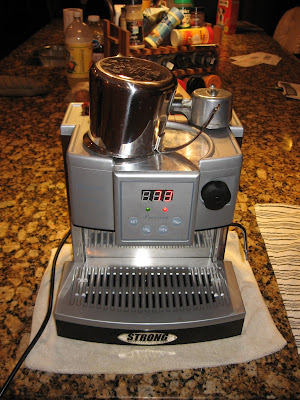Unfortunately, life is seldom that simple. One day the new machine, Precisia, would no longer make espresso. I could hear the pump running and verified that it would pump water but it was unable to pump at enough pressure to actually make espresso. While the machine was not particularly expensive, it did have a PID control (electronics to control how the heater was run to insure accurate brewing temperatures) and I decided to try and repair it.
Here's what the insides of a home espresso machine looks like.
The bit on the left is the boiler where water is heated, steam made, etc. The red bit on the right is the pump. It's a vibrator self priming pump. A bit of investigation revealed that it had partially failed. It would pump but was unable to create enough pressure to make espresso.
Here's what the pump looks like removed. The bit on the right is a pressure regulator and overpressure bypass valve assembly.When I removed the valve assembly from the pump it looked like this. The red bit is an O ring to seal the assembly against the pump's 15 bar pressure. It was clearly non-functional.
When I took the pump apart I found that one of the springs had broken. Clearly the source of the problem.
The original pump was a Chinese knockoff of the more or less standard ULKA pump used in almost all home machines. So I got an ULKA and repaired the machine. The result, a better than new home espresso machine.






No comments:
Post a Comment